1st part: The mausoleum, a national symbol
Welcome to our one-day city tour in Hanoi!
After our morning visit to the
Tran Quoc Pagoda, we are now heading to an iconic place in the Vietnamese capital: the
Ho Chi Minh Mausoleum Complex, located on the famous Ba Dinh Square.
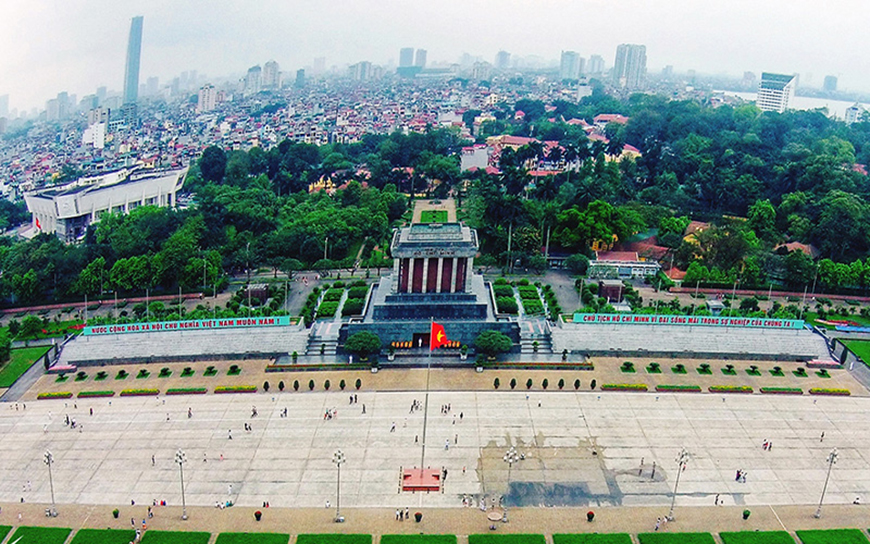
Aerial view of Ba Dinh Square - Source : Vietnam Net
Ba Dinh Square
Ba Dinh Square, the true heart of Hanoi, is much more than a simple esplanade. This historically charged place has witnessed crucial moments for Vietnam. Its name pays tribute to a resistance army that fought against the French colonizers in the Thanh Hoa province at the end of the 19th century. With its impressive dimensions of 367 meters long and 85 meters wide, it can accommodate up to 200,000 people.
One of the most striking elements of the square is its landscaping. The 210 squares of grass, connected by wide paths, are not there by chance. They symbolize the rebirth of the Vietnamese nation after years of conflict, while evoking peace and harmony. Beyond their aesthetic aspect, these green spaces play a practical role in regulating the temperature and creating a pleasant environment for visitors.
A history marked by colonization
French rule: Before becoming the beating heart of independent Vietnam, Ba Dinh Square served as the administrative center of the Indochinese Federation. There was a floral park there, named Puginier Park - or Puginier Roundabout, in honor of Paul-François Puginier, a missionary and architect who played a role in the construction of St. Joseph's Cathedral in Hanoi.
The turning point of 1945: It was on this very square, on September 2, 1945, that Ho Chi Minh read the Declaration of Independence, thus marking the birth of the Democratic Republic of Vietnam. This historic event gave the square an unparalleled symbolic dimension.
Since then, the square has remained at the heart of national political life, hosting many official ceremonies.
Around the square and near the famous unique pillar pagoda, a monumental complex dedicated to the memory of Ho Chi Minh gradually formed, including his mausoleum, his stilt house, and a museum dedicated to Uncle Ho.
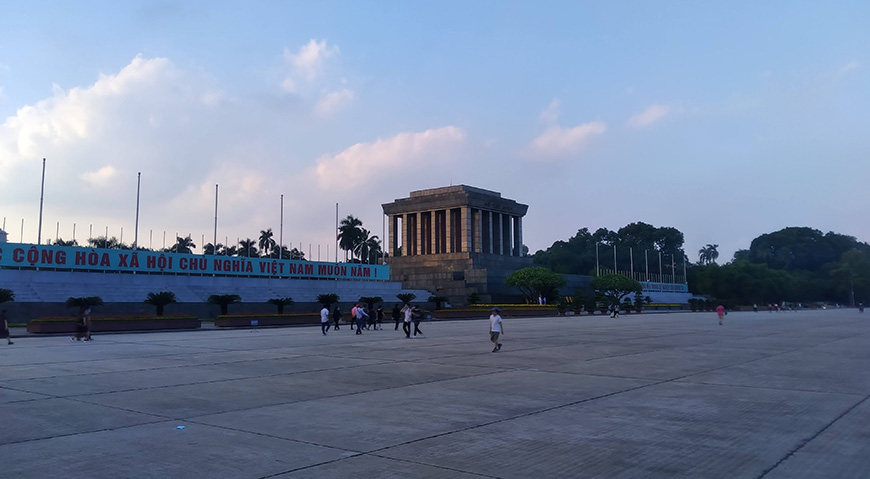
The architectural style of the mausoleum is inspired by Soviet neoclassicism - Source : Mr Linh's Adventure Team
Ho Chi Minh Mausoleum: Architecture rich in symbols
Built between 1973 and 1975, the Ho Chi Minh Mausoleum is much more than a simple resting place for the revolutionary leader: it is a national monument, a place of pilgrimage, and a complex architectural work that embodies national unity and perpetuates the legacy of the "Father of the Nation". At the front of the mausoleum is the inscription "CHỦ TỊCH HỒ CHÍ MINH", which means "President Ho Chi Minh". As for the phrase at the entrance of the mausoleum, it is attributed to Ho Chi Minh himself: "Nothing is more precious than Independence and Freedom".
Construction and architecture of the Mausoleum
Soviet influence
The architectural style of the mausoleum is inspired by Soviet neoclassicism, a popular trend in communist countries of the time. This influence is particularly evident in the simple lines, the cubic shape, and the use of noble materials. However, despite these foreign influences, the architects managed to adapt this model to the Vietnamese context by integrating traditional elements and using local materials.
Noble materials
Granite, chosen for its durability and beauty, is the main material used in construction. This choice of construction materials is not incidental. This hard and resistant stone symbolizes the permanence of Ho Chi Minh's work and the eternity of the Vietnamese nation. Inside the mausoleum, white marble is used for Ho Chi Minh's sarcophagus. This material, associated with purity and nobility, emphasizes the veneration of the leader.
Strong symbolism
The cubic shape and clean lines evoke solidity and eternity, reflecting the enduring legacy of Ho Chi Minh.
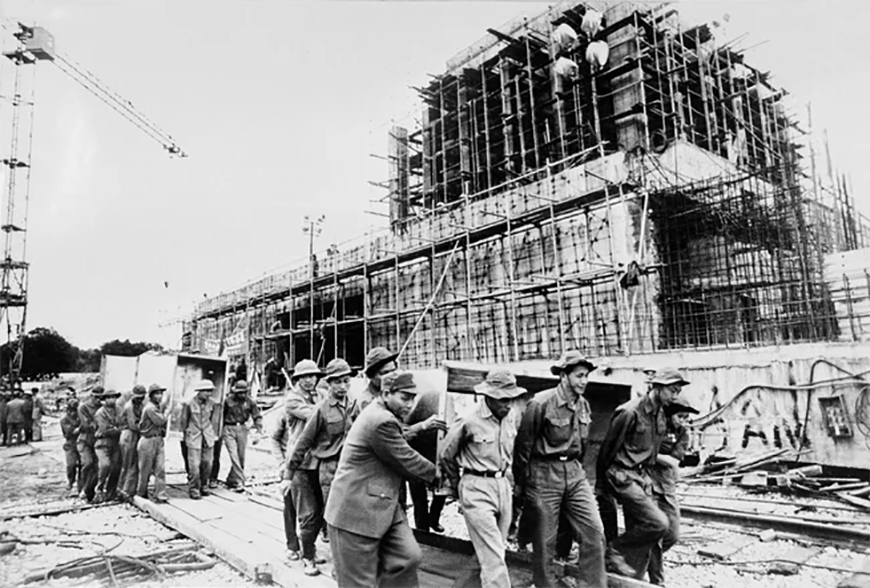
Construction lasted from 1973 to 1975 - Source : Internet
History and context
Passed away on September 2, 1969, amidst the turmoil of the Vietnam War, Ho Chi Minh's death was announced a day later, out of respect for the national holiday. Although in his will he expressed the wish to be cremated and his ashes scattered in the country's three regions, the will of the Party and the people prevailed. The President's body was embalmed and placed in a mausoleum, allowing the Vietnamese people to continue to pay him tribute. In January 1970, the design of this monument was the result of a collaboration between Vietnam and the Soviet Union. Soviet experts, renowned for their expertise in this field, provided valuable assistance in realizing this project, approved by the Vietnamese Politburo.
The mausoleum today: a pillar of the regime
A true national sanctuary, Ho Chi Minh's mausoleum embodies the unity of the Vietnamese people around the tutelary figure of its founder. As the ultimate pilgrimage site, it reinforces the sense of belonging to a single nation.
By maintaining the memory of Ho Chi Minh, the Vietnamese communist regime ensures historical legitimacy. Presented as the father of the nation, Ho Chi Minh gives the regime timeless legitimacy.
Furthermore, the mausoleum plays an essential role in patriotic education. This is where the younger generations learn to honor the country's revolutionary past and perpetuate the values of their elders.
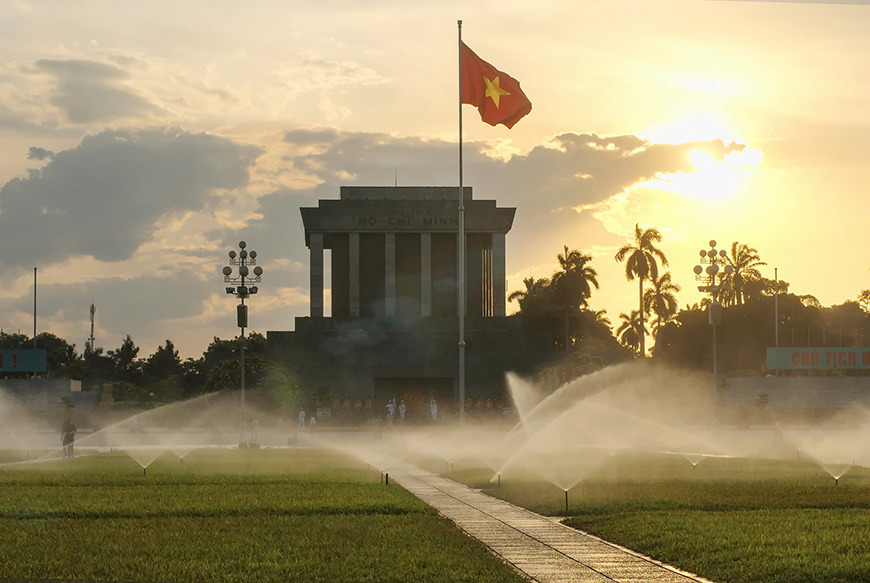
Ba Dinh and its 210 squares of grass - Source : Mr Linh's Adventures
Visit to the mausoleum, practical information
Address: Hung Vuong Street, Dien Bien Ward, Ba Dinh District, Hanoi
To get there, you can use a private vehicle or a public bus. If you come by private vehicle, prioritize parking on Ong Ich Khiem Street (facing the guard command) or Ngoc Ha Street (near the museum). By public transport, bus lines 09, 34, and 22 serve Ba Dinh Square. They stop at Le Hong Phong Street, in the immediate vicinity.
Opening hours
Opening hours vary by season
♦ Hot season (April 1 - October 31):
• Tuesday, Wednesday, Thursday: 7:30 am - 10:30 am
• Saturday: 7:30 am - 11:00 am
♦ Cold season (November 1 - March 31):
• Tuesday, Wednesday, Thursday: 8:00 am - 11:00 am
• Saturday: 8:00 am - 11:30 am
The mausoleum is closed on Mondays and Fridays, and for two months a year for restoration work.
Entrance fee: 25,000 VND for foreign tourists, while Vietnamese citizens enjoy free access.
Good to know: Ho Chi Minh's mausoleum is usually closed to the public for two to three months in autumn, to allow for restoration and preservation of the remains. Please enquire, as exact dates vary from year to year.
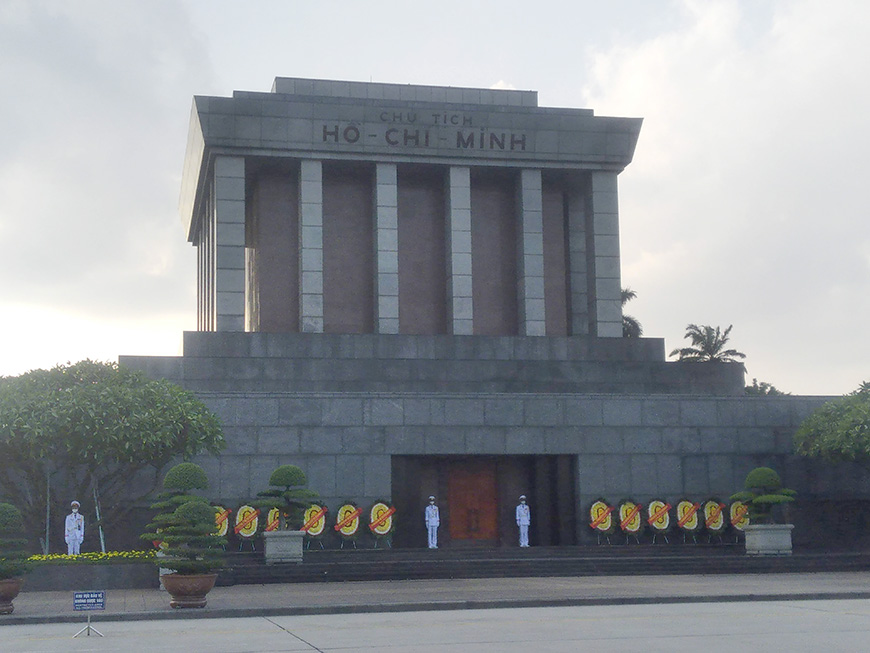
Front view of Ho Chi Minh Mausoleum - Source : Mr Linh's Adventures Team
Customs to be observed when visiting the mausoleum
Visiting Ho Chi Minh's mausoleum is a moment of meditation and respect for the memory of the father of the Vietnamese nation. It is therefore important to respect certain rules:
- - Attire: Sober, decent dress is required. Shoulders must be covered, shorts and short skirts are forbidden.
- - Silence: Silence must be respected inside the mausoleum. Conversation is forbidden.
- - Cell phones: Mobile phones must be switched off.
- - Photos and videos: It is generally forbidden to take photos and videos inside the mausoleum.
- - Attitude: A respectful attitude is required. Loose gestures and noise are to be avoided.
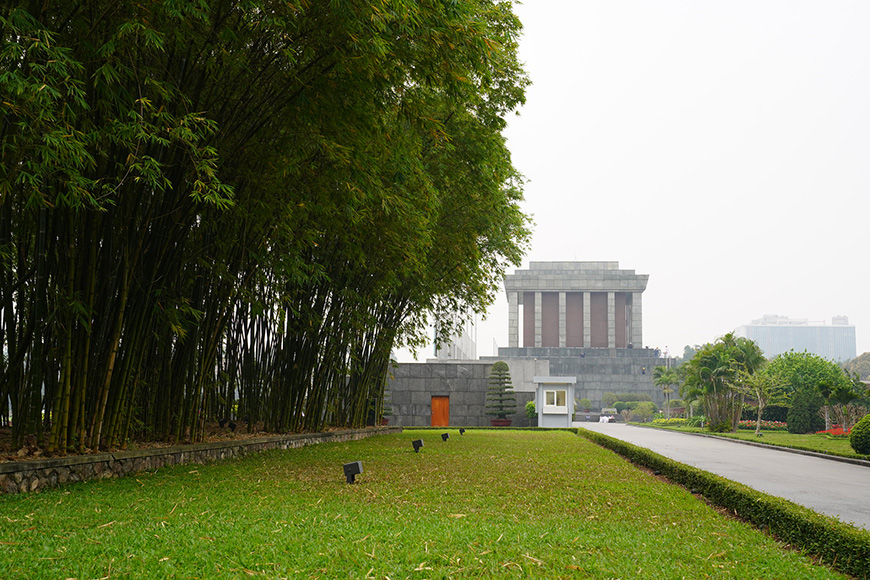
Side view of President Ho Chi Minh Mausoleum - Source : Mr Linh's Adventures
In conclusion
The Ho Chi Minh Mausoleum Complex stands as a powerful tribute to Vietnam's revolutionary leader, offering visitors a profound glimpse into the nation's history and culture.
The serene surroundings, coupled with the architectural grandeur of the mausoleum and accompanying sites, create a reflective space that honors Ho Chi Minh's legacy. For travelers, this complex not only serves as a historical landmark but also as a reminder of the enduring spirit of the Vietnamese people. A visit here is both an educational and emotional experience, making it a must-see destination in Hanoi.